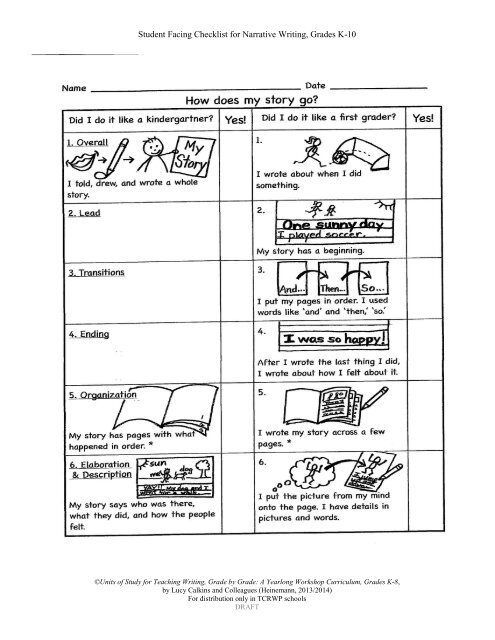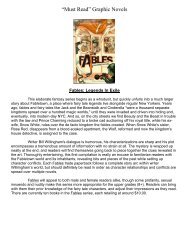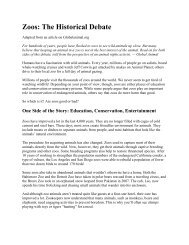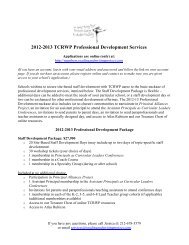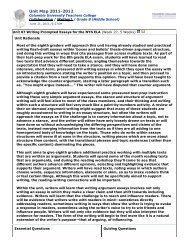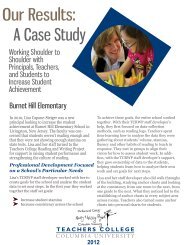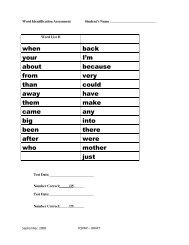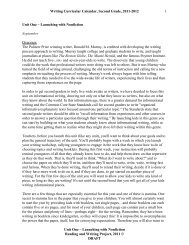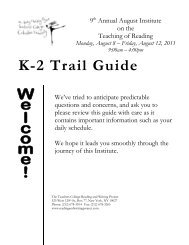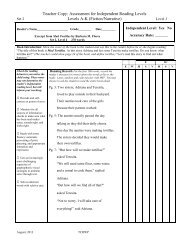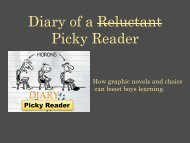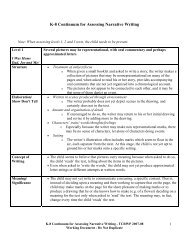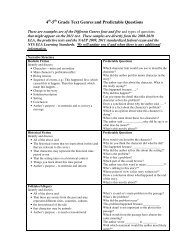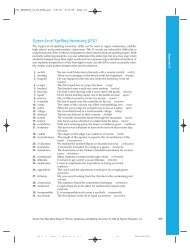Student Facing Checklist for Narrative Writing, Grades K-10
Student Facing Checklist for Narrative Writing, Grades K-10
Student Facing Checklist for Narrative Writing, Grades K-10
You also want an ePaper? Increase the reach of your titles
YUMPU automatically turns print PDFs into web optimized ePapers that Google loves.
<strong>Student</strong> <strong>Facing</strong> <strong>Checklist</strong> <strong>for</strong> <strong>Narrative</strong> <strong>Writing</strong>, <strong>Grades</strong> K-<strong>10</strong><strong>Narrative</strong> <strong>Checklist</strong>KindergartenYes!I told, drew, and wrote a whole story.My story has pages with what happened in order.My story says who was there, what they did, andhow the people felt.I can read my writing.I wrote a letter <strong>for</strong> every sound I hear.I wrote spaces between words.I wrote capital letters to start every sentence.©Units of Study <strong>for</strong> Teaching <strong>Writing</strong>, Grade by Grade: A Yearlong Workshop Curriculum, <strong>Grades</strong> K-8,by Lucy Calkins and Colleagues (Heinemann, 2013/2014)For distribution only in TCRWP schoolsDRAFT
<strong>Student</strong> <strong>Facing</strong> <strong>Checklist</strong> <strong>for</strong> <strong>Narrative</strong> <strong>Writing</strong>, <strong>Grades</strong> K-<strong>10</strong>OverallLeadTransitionsEndingOrganizationElaboration<strong>Narrative</strong> <strong>Checklist</strong>Grade 3StructureI told the story bit by bit.The beginning shows a person saying or doingsomething.I told my story in order by using phrases like alittle later, or after that.I chose the action, talk or feeling that would makea good ending, and worked to write it well.I worked on the beginning, middle, and end of mystory.DevelopmentI worked to show what was happening to (and in)my characters.Yes!StartingToNot YetDescriptionI didn’t just tell my story, I wrote my story in waysthat got readers to picture what was happening andto bring my story to life.Spelling andPunctuationLanguage ConventionsI used what I know about word families andspelling rules to help me spell and edit.I punctuated dialogue correctly, with commas andquotation marks. I used punctuation to fix my runonsentences.I wrote in ways that helped readers read withexpression, reading some parts quickly, someslowly, some parts in one sort of voice and otherin another.©Units of Study <strong>for</strong> Teaching <strong>Writing</strong>, Grade by Grade: A Yearlong Workshop Curriculum, <strong>Grades</strong> K-8,by Lucy Calkins and Colleagues (Heinemann, 2013/2014)For distribution only in TCRWP schoolsDRAFT
<strong>Student</strong> <strong>Facing</strong> <strong>Checklist</strong> <strong>for</strong> <strong>Narrative</strong> <strong>Writing</strong>, <strong>Grades</strong> K-<strong>10</strong>OverallLeadTransitionsEnding<strong>Narrative</strong> <strong>Checklist</strong>Grade 4StructureI wrote the important part of an event, bit by bitand took out unimportant parts.I wrote a beginning that shows what is happeningand where. It gets the reader into the world of thestory.I used words and phrases to show how much timewent by, with phrases that mark time, like justthen, suddenly (to show when things happenedquickly) or after a while, a little later (to showwhen a little time passed).What happens at the end of the story connects tothe beginning or the middle.Yes!StartingToNot YetOrganizationElaborationDescriptionI used action, dialogue, or feeling to bring my storyto a close.I used paragraphs to separate the different partsor times of the story, or to show when a newperson is speaking.DevelopmentI added more to the heart of my story, includingnot only actions and dialogue but also thought andfeelings.I showed why characters do what they do byincluding their thinking.I made some parts of the story go quickly, someslowly.I included precise and sometimes sensory detailsand used figurative language (simile, metaphor,personification) to bring my story to life.SpellingPunctuationI used a storytelling voice and conveyed theemotion or tone of my story through description,phrases, dialogue, and thoughts.Language ConventionsI used what I know about word families andspelling rules to help me spell and edit. I used theword wall and dictionaries to help me whenneeded.When writing long, complex sentences, I usedcommas to make them clear and correct.©Units of Study <strong>for</strong> Teaching <strong>Writing</strong>, Grade by Grade: A Yearlong Workshop Curriculum, <strong>Grades</strong> K-8,by Lucy Calkins and Colleagues (Heinemann, 2013/2014)For distribution only in TCRWP schoolsDRAFT
<strong>Student</strong> <strong>Facing</strong> <strong>Checklist</strong> <strong>for</strong> <strong>Narrative</strong> <strong>Writing</strong>, <strong>Grades</strong> K-<strong>10</strong>SpellingLanguage ConventionsI used what I know about word families andspelling rules to help me spell and edit.I used the word wall and dictionaries when needed.PunctuationI used commas to set off introductory arts ofsentences. (One day at the park, I went on the slide.)I also used commas to show talking directly tosomeone (Are you mad, Mom?).©Units of Study <strong>for</strong> Teaching <strong>Writing</strong>, Grade by Grade: A Yearlong Workshop Curriculum, <strong>Grades</strong> K-8,by Lucy Calkins and Colleagues (Heinemann, 2013/2014)For distribution only in TCRWP schoolsDRAFT
<strong>Student</strong> <strong>Facing</strong> <strong>Checklist</strong> <strong>for</strong> <strong>Narrative</strong> <strong>Writing</strong>, <strong>Grades</strong> K-<strong>10</strong>OverallLeadTransitionsEnding<strong>Narrative</strong> <strong>Checklist</strong>Grade 7StructureI created a narrative that has realistic characters,tension and change, and that not only conveys, butalso develops an idea or lesson.The beginning not only sets the story in motion, italso grounds it in a place or situation. It includesdetails that will later be important to the storyI used transitional phrases to alert my reader tothe passage of time, to connect parts of thestory,(and suddenly, if only, meanwhile)I wrote an ending that conveys change and thatclarifies the meaning (develops the issue, idea,moral, or lesson)Yes!StartingToNot YetI have the reader a sense of closure by showing clearlyhow the character or place has changed or the problemhas been resolved.OrganizationI used narrative paragraphs to clarify when timechanges, when the setting changes, or <strong>for</strong>dramatic impact.The narrative structure is mostly conventional andlinear, and the sequence of events is clear.ElaborationDevelopmentI developed the action, dialogue, details, and innerthinking to develop the issue, idea, moral, orlesson.I developed the central character as well as thesetting and the character’s relationship to thesetting.DescriptionI developed characters’ motivations and showedwhy characters do what they do. I developed some ofthe complexity and change in characters.I used specific details to help the reader picture theplace and the mood.I stretched out parts that seemed significant to themeaning, and summarized parts that act as transitions.I varied my language and sentence structure tomatch the tone and the characters.©Units of Study <strong>for</strong> Teaching <strong>Writing</strong>, Grade by Grade: A Yearlong Workshop Curriculum, <strong>Grades</strong> K-8,by Lucy Calkins and Colleagues (Heinemann, 2013/2014)For distribution only in TCRWP schoolsDRAFT
<strong>Student</strong> <strong>Facing</strong> <strong>Checklist</strong> <strong>for</strong> <strong>Narrative</strong> <strong>Writing</strong>, <strong>Grades</strong> K-<strong>10</strong>SpellingPunctuationLanguage ConventionsI used the technological and other sources at handto check spelling of literary and high frequencywords.I used punctuation to help me change mood,convey meaning and/ or build tension in mystory. I punctuate dialogue accurately.©Units of Study <strong>for</strong> Teaching <strong>Writing</strong>, Grade by Grade: A Yearlong Workshop Curriculum, <strong>Grades</strong> K-8,by Lucy Calkins and Colleagues (Heinemann, 2013/2014)For distribution only in TCRWP schoolsDRAFT
<strong>Student</strong> <strong>Facing</strong> <strong>Checklist</strong> <strong>for</strong> <strong>Narrative</strong> <strong>Writing</strong>, <strong>Grades</strong> K-<strong>10</strong>OverallLead<strong>Narrative</strong> <strong>Checklist</strong>Grade 8StructureI not only created a narrative with characters,tension, change, and an idea/lesson, but I alsomade the characters complex.In establishing the situation and place, I hint at abigger context <strong>for</strong> the story (issues that have beenbrewing, a time in history, one out of many points ofview). When the story starts, I also hint at what willcome later in the story, including not just the plot butthe ideas.Yes!StartingToNot YetTransitionsEndingI used transitional phrases to alert my reader tothe passage of time, to connect parts of the story, toimply cause and effect, to raise questions (and so,thereabouts, whenever, wherever, in spite of)I wrote an ending that continues to develop themeaning and that suggests a stance on the issue, idea,moral, lesson, or theme.I gave the reader a sense of closure by showingcharacter change or a resolution of one of theproblems. Something clearly changes.OrganizationI used narrative paragraphs to clarify dialogue,time change, shifts in the setting or mood, and <strong>for</strong>dramatic impact.The narrative structure may offer shifts in time orparallel narratives and the sequence of events iscarefully managed and clear.ElaborationDevelopmentI developed the action, dialogue, details, and innerthinking to develop the issue, idea, moral, orlesson or theme. Details clearly relate to andconvey meaning.I developed the central character as well as thesetting and the character’s relationship to thesetting.©Units of Study <strong>for</strong> Teaching <strong>Writing</strong>, Grade by Grade: A Yearlong Workshop Curriculum, <strong>Grades</strong> K-8,by Lucy Calkins and Colleagues (Heinemann, 2013/2014)For distribution only in TCRWP schoolsDRAFT
<strong>Student</strong> <strong>Facing</strong> <strong>Checklist</strong> <strong>for</strong> <strong>Narrative</strong> <strong>Writing</strong>, <strong>Grades</strong> K-<strong>10</strong>DescriptionI conveyed the pressures that are felt bycharacters as well as their hopes and dreams. Irelated their actions to what they want and how theytend to behave. I developed characters that arecomplicated and who change.I used specific details to show a place and itsatmosphere and how it changes or feels to thecharacters.I varied the pacing to increase tension andmanage time.I matched my language and sentence structure to thetone of parts of the story, and to different characters.SpellingPunctuationLanguage ConventionsI used technological and other sources to check thespelling of literary, historical, geographical words.I used punctuation to help me change mood,convey meaning and/ or build tension in my story aswell as develop dialogue and characterization. Ipunctuate complex dialogue accurately.©Units of Study <strong>for</strong> Teaching <strong>Writing</strong>, Grade by Grade: A Yearlong Workshop Curriculum, <strong>Grades</strong> K-8,by Lucy Calkins and Colleagues (Heinemann, 2013/2014)For distribution only in TCRWP schoolsDRAFT
<strong>Student</strong> <strong>Facing</strong> <strong>Checklist</strong> <strong>for</strong> <strong>Narrative</strong> <strong>Writing</strong>, <strong>Grades</strong> K-<strong>10</strong>OverallLead<strong>Narrative</strong> <strong>Checklist</strong>Grade 9/<strong>10</strong>StructureI not only created a narrative with characters, tension,change, and an idea/lesson, and made the charactercomplex, I also developed particular perspectives, orpoints of view.The beginning defines a situation, place, atmosphere,sets it within some kind of context, <strong>for</strong>eshadows theproblem(s), and raises questions about issues, ideas,morals, lessons, and themes. It also introduces aparticular narrative voice and point of view.Yes!StartingToNot YetTransitionsEndingI used transitional phrases to alert my reader tothe passage of time, to connect parts of the story,to imply cause and effect, to raise questions anddoubts, to make allusions (as when, just as, whereby,without realizing, ever afterward)I wrote an ending that develops the meaning and mayact as social commentary.I gave the reader a sense of closure by showingcharacter change, multiple perspectives, or ifproblems are not resolved, there is a sense ofbearing witness.OrganizationI used narrative paragraphs and font changes toclarify dialogue, times change, shifts in the setting ormood, interior dialogue, and <strong>for</strong> dramatic impact.The narrative structure may include non-linear parts,including shifts in time, parallel narratives, dreamsequences, multiple perspectives - and these areclear.ElaborationDevelopmentI developed the action, dialogue, details, and innerthinking to develop the issue, idea, moral, lesson, ortheme. Details clearly relate to and suggest meaning.They may <strong>for</strong>eshadow and hint at symbolism.I developed minor as well as central characters as wellas a sense of place.©Units of Study <strong>for</strong> Teaching <strong>Writing</strong>, Grade by Grade: A Yearlong Workshop Curriculum, <strong>Grades</strong> K-8,by Lucy Calkins and Colleagues (Heinemann, 2013/2014)For distribution only in TCRWP schoolsDRAFT
<strong>Student</strong> <strong>Facing</strong> <strong>Checklist</strong> <strong>for</strong> <strong>Narrative</strong> <strong>Writing</strong>, <strong>Grades</strong> K-<strong>10</strong>DescriptionI developed characters over scenes, letting the readerget to know their tendencies and emotions, their hopes,their troubles. I showed how they respond to trouble andcreated characters that are complicated, changing, andcompelling.I created a mood as well as a physical setting, andshowed how the place changed, or its relationships tothe characters changes.I varied the pace to increase tension, develop meaning,and manage time.I matched my language and sentence structure to thetone of parts of the story, to convey time and place,and to develop different characters.SpellingPunctuationLanguage ConventionsSpelling has been checked <strong>for</strong> accuracy, includingdouble checking homonyms and technologicalmishaps.I control conventions and use them accurately andartfully to enhance meaning.©Units of Study <strong>for</strong> Teaching <strong>Writing</strong>, Grade by Grade: A Yearlong Workshop Curriculum, <strong>Grades</strong> K-8,by Lucy Calkins and Colleagues (Heinemann, 2013/2014)For distribution only in TCRWP schoolsDRAFT
<strong>Student</strong> <strong>Facing</strong> <strong>Checklist</strong> <strong>for</strong> <strong>Narrative</strong> <strong>Writing</strong>, <strong>Grades</strong> K-<strong>10</strong>©Units of Study <strong>for</strong> Teaching <strong>Writing</strong>, Grade by Grade: A Yearlong Workshop Curriculum, <strong>Grades</strong> K-8,by Lucy Calkins and Colleagues (Heinemann, 2013/2014)For distribution only in TCRWP schoolsDRAFT


